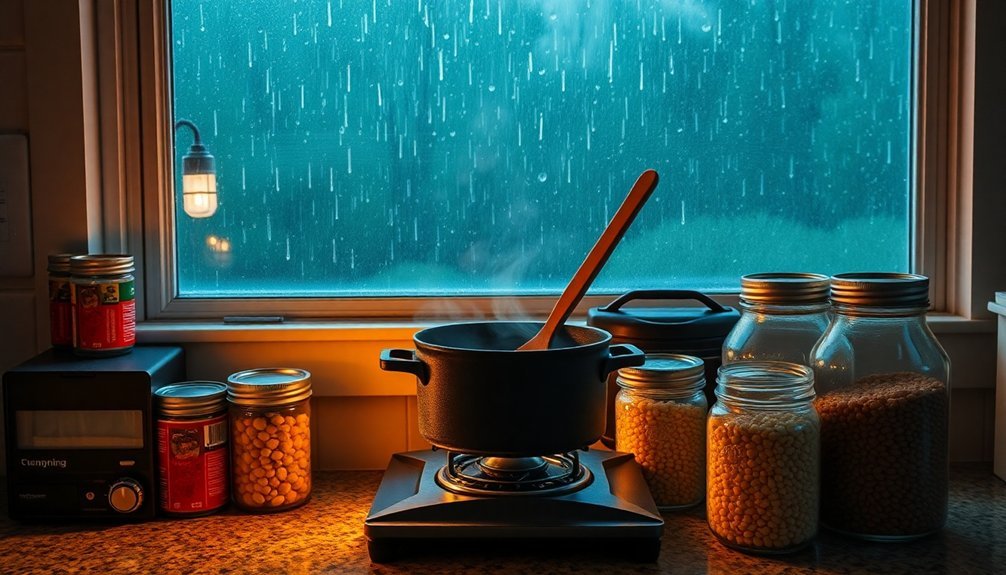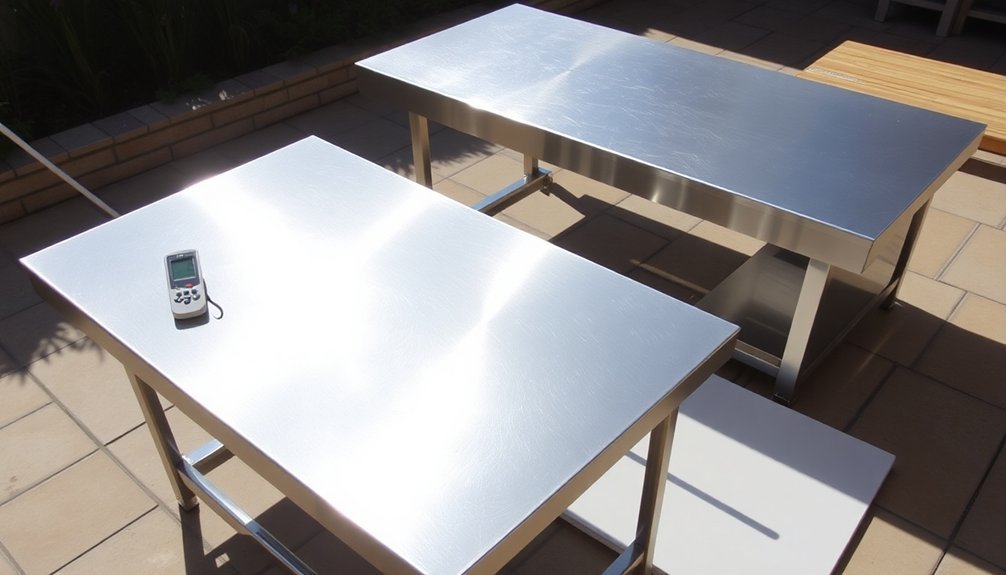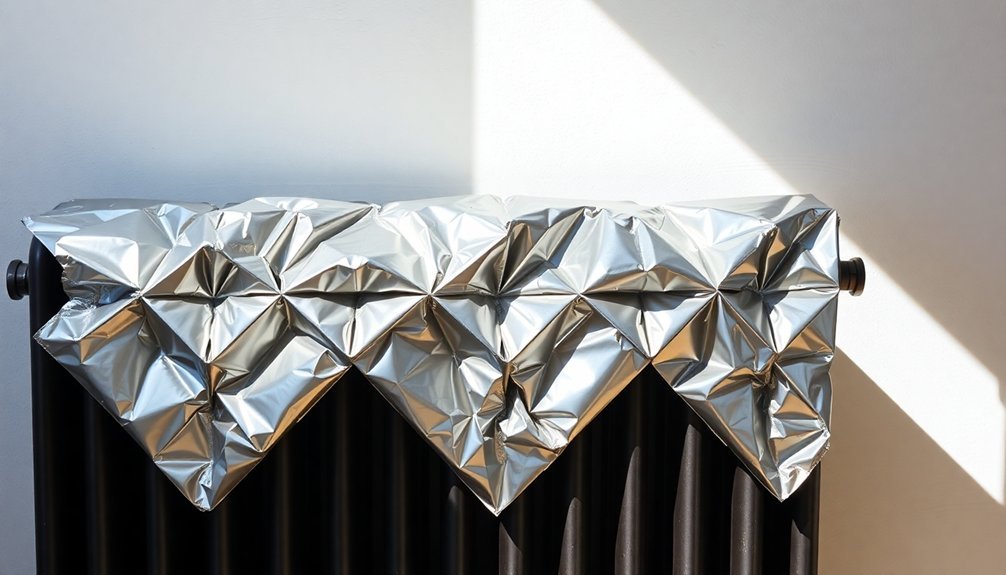You'll find multiple reliable ways to prepare hot meals during bad weather, even when your usual cooking methods aren't available. Consider using a Dutch oven with proper coal placement, setting up a hay box cooker for slow-cooking stews, or utilizing a thermal cooker that works like a large thermos. You can also create an emergency kitchen setup with propane camp stoves, rely on fire pit cooking with proper safety measures, or employ nonperishable meal planning strategies. Don't forget indoor heating solutions and safe food storage techniques to maintain food quality. These proven methods will help you keep your family well-fed when storms strike, and there's even more to discover about weatherproof cooking.
Solar Oven Alternatives

When severe weather strikes, relying solely on a solar oven can leave you without a way to prepare meals. You'll need reliable backup cooking methods to guarantee you can continue preparing food during cloudy, stormy, or winter conditions.
Keep fuel-based or electric cookers readily accessible as alternatives. These options become essential when your solar oven can't function due to low UV index levels or complete cloud coverage. High winds over 35 mph can also disrupt outdoor solar cooking, making indoor alternatives necessary.
Consider investing in thermal cookers, which can maintain cooking temperatures for extended periods without constant heat input.
You'll want to maintain a supply of appropriate fuel for your backup cooking methods and store them in a dry, accessible location.
Plan your meals around the cooking resources you have available, and make sure you're familiar with using these alternative methods before bad weather arrives.
Thermal Cooking Methods
Among the reliable backup options mentioned, thermal cooking stands out as a particularly effective method for meal preparation during adverse weather.
You'll find these cookers work like large thermos bottles, keeping your food warm and cooking for hours without additional heat.
To use a thermal cooker, you'll need to bring your food to a full boil on a stove or campfire before transferring it to the insulated container.
Having multiple cooking methods available ensures you're well-prepared when one option isn't feasible.
Modern versions like the Saratoga Jacks offer versatile cooking options for stews, roasted vegetables, and various other meals.
You'll appreciate how energy-efficient these cookers are during power outages or emergencies.
They're also perfect for camping trips.
Just remember to monitor cooking times and temperatures carefully to guarantee food safety, and always use clean utensils to prevent contamination.
Indoor Emergency Heat Sources

When your power goes out during bad weather, you'll need safe indoor heating options to cook meals and stay warm.
You can rely on propane heaters equipped with safety features like oxygen depletion sensors and tip-over protection, or opt for catalytic heaters placed near partially open windows for proper ventilation.
Whether you choose kerosene, biofuel, or terracotta pot heaters, always follow manufacturer guidelines and maintain adequate airflow to prevent dangerous gas buildup. Having carbon monoxide detectors is essential when using any combustion-based heating sources indoors.
Safe Indoor Heat Options
During power outages and severe weather, having reliable indoor heat sources becomes essential for both warmth and meal preparation.
A portable butane stove provides one of the safest and most effective indoor cooking solutions during emergencies.
You'll find several safe options to keep your living space warm while cooking meals. Portable propane heaters offer a reliable solution when used in well-ventilated areas, while indoor-rated butane stoves provide efficient cooking capabilities.
If you have a fireplace or wood stove, you can use them for both heating and cooking with proper tools like Dutch ovens. While kerosene heaters work as a last resort, they require extra precautions and ventilation.
- Your family's safety depends on choosing the right heat source
- You'll feel confident knowing you can prepare hot meals during emergencies
- You won't have to worry about your children going hungry
- You can maintain a sense of normalcy during stressful situations
- You'll have peace of mind with proper safety measures in place
Emergency Heat Safety Rules
Safe operation of indoor emergency heat sources requires strict adherence to essential safety rules.
You'll need to guarantee proper ventilation by keeping a window slightly open and using a battery-powered carbon monoxide detector in the heated space. Never use charcoal indoors, as it produces deadly carbon monoxide.
When using kerosene heaters, only use 1-K grade fuel and refuel outdoors. Place your heating device on stable surfaces away from flammable materials and overhangs.
Don't block airflow around the unit. If you're using a fireplace, verify the flue is open. For gas heaters, know where the shut-off valve is located.
You'll want to maintain your heating devices regularly and keep emergency numbers nearby. Always follow the manufacturer's guidelines for safe operation and proper maintenance.
Nonperishable Meal Planning
Successful nonperishable meal planning begins with a thorough assessment of your pantry staples and their potential combinations.
You'll want to organize your ingredients into meal kits and create theme nights to keep dining interesting during bad weather. Stock up on versatile items like dried beans, pasta, rice, and baking essentials that'll help you prepare diverse meals without relying on perishables.
- Keep your family's spirits high with comforting cocoa nights during storms
- Create exciting Mexican-themed dinners using shelf-stable ingredients
- Transform simple rice and beans into globally-inspired dishes
- Make memories with family baking sessions using pantry staples
- Feel secure knowing you're prepared with organized meal kits
Remember to include manual can openers and alternative cooking methods in your planning, ensuring you can prepare meals even during power outages.
Safe Food Storage Techniques

You'll want to keep your food fresh during bad weather by storing items at proper temperatures and using airtight containers.
Following the temperature control zone guidelines, maintain cold foods below 40°F and hot foods above 140°F to prevent bacterial growth.
Don't let foods sit between 45°F and 135°F for more than two hours, as this "danger zone" can quickly lead to spoilage.
Keep Food Fresh Longer
Proper food storage techniques can make the difference between having fresh, safe meals and wasting money on spoiled food during bad weather.
You'll want to divide large portions into shallow containers for quick cooling and package leftovers in airtight containers within two hours.
For freezer storage, use moisture-resistant wraps and leave space for expansion.
Keep your pantry organized using the FIFO method and store dry goods in sealed containers away from chemicals.
- Don't let your family's health be compromised by improper food storage
- Protect your investment in groceries by storing them correctly
- Save money by preventing food waste through proper organization
- Keep your loved ones safe from foodborne illness
- Guarantee you'll have fresh, nutritious meals when you need them most
Temperature Control Zone Guidelines
When storing food during bad weather, understanding temperature control zones becomes critical for preventing foodborne illness. Keep your food out of the danger zone (41°F-135°F) where bacteria multiply rapidly. Don't let food sit at room temperature for more than four hours.
For hot foods, maintain temperatures at 135°F or above. If you're cooling leftovers, follow the two-step process: cool from 135°F to 70°F within two hours, then down to 41°F within four hours. Use shallow containers and ice baths to speed up cooling.
For cold foods, keep them at 41°F or below. Check food temperatures every two hours during storage. Label containers with contents and dates, and don't overload your refrigerator with warm items. Use airtight containers to maintain quality and prevent contamination.
Fire Pit Cooking Basics
Fire pit cooking combines four key elements: proper setup, fuel management, essential tools, and proven techniques.
When cooking outdoors in challenging weather, you'll need to select a protected location away from high winds and flammable materials. Build your pit on a stone base with a u-shaped design for easy wood feeding, and keep water or sand nearby for safety.
Use dry hardwood or charcoal for peak heat, and control temperatures by adjusting food distance from the embers.
- Watch flames dance and embers glow as you master the primal art of fire cooking
- Feel the satisfaction of perfectly seared meat over hot coals you've carefully tended
- Experience the rich, aromatic pleasure of wood-smoke flavoring your food
- Embrace the warmth of gathering around the fire pit while your meal cooks
- Savor the rewarding taste of dishes prepared with time-honored techniques
Dutch Oven Meal Solutions

You'll need basic Dutch oven equipment like a lid lifter, heat-resistant gloves, and coal tongs to safely manage your outdoor cooking setup.
To control temperature effectively, you can follow the one-third rule with your coals and rotate your Dutch oven every 15 minutes for even heating.
Whether you're making a hearty stew, baking cornbread, or simmering a camp chili, your Dutch oven lets you create satisfying one-pot meals even in challenging weather conditions.
Essential Dutch Oven Equipment
Successful Dutch oven cooking requires four key equipment categories: the oven itself, protective tools, fuel management items, and food prep essentials.
Choose a 12-inch Dutch oven for family-size meals serving 10-12 people, or opt for smaller sizes like 10-inch or 6-inch models for sides and sauces.
You'll need protective gear, including elbow-length gloves and a lid lifter, to handle your hot cookware safely.
- Your trusty Dutch oven becomes your shelter from hunger in stormy weather
- Nothing beats the satisfaction of lifting a perfectly cooked meal from the coals
- Protected hands mean confident cooking, even in challenging conditions
- Well-arranged coals transform your pot into a reliable outdoor oven
- Basic prep tools guarantee you're ready to create comfort food when it matters most
For fuel management, you'll want charcoal briquettes, metal trays, and fire tongs.
Don't forget essential prep items like mixing bowls, cooking thermometers, and aluminum foil.
Temperature Control Tips
Armed with the right equipment, mastering temperature control becomes your next challenge in Dutch oven cooking.
You'll find the Dinwiddie Ring Method invaluable for maintaining consistent temperatures in challenging weather conditions. This simple system uses ring formations of coals to achieve specific heat levels, from 300°F to 500°F.
For reliable results, follow the one-third rule: place fewer coals on the bottom than the top to prevent burning. When baking, you'll want to reduce heat to avoid drying out your food. If you're cooking meat or potatoes, increase the heat accordingly.
Position your coals in a ring formation around the lid, with a few near the handle for even distribution. Remember to monitor and adjust coal placement regularly to maintain your target temperature throughout the cooking process.
One-Pot Camping Recipes
While bad weather can challenge even experienced campers, Dutch oven cooking offers reliable one-pot meal solutions that satisfy hungry outdoor enthusiasts.
You'll find that its cast-iron construction and non-enameled surface make it perfect for harsh conditions, while the raised feet and flat lid allow for ideal coal placement.
You can prepare everything from hearty chili to comforting mac and cheese, making the most of your ingredients while staying dry and warm.
- Savor the aroma of bubbling homestyle jambalaya as rain patters on your tent
- Watch your family's eyes light up as you reveal a golden-brown apple cobbler
- Create lasting memories with shared one-pot breakfasts on misty mornings
- Transform basic ingredients into soul-warming chicken marbella
- Experience the joy of pulling perfect lasagna from your campfire kitchen
Hay Box Cooking Essentials
An insulated cooking method that dates back over a century, haybox cooking offers a practical solution for meal preparation during adverse weather.
You'll need a pot with a tight-fitting lid and insulating materials like straw, polystyrene beads, or shredded newspaper. Modern alternatives include insulated coolers or Wonderbags for better hygiene.
To use this method, bring your ingredients to a boil on the stove, then transfer the covered pot to your insulated container. Pack the insulating material around the pot to retain heat. Your food will continue cooking slowly over several hours without additional fuel.
This technique works best for liquid-based dishes like soups and stews. While it's an efficient way to cook, remember to check food temperature to prevent bacterial growth.
Power Outage Food Preservation

During unexpected power outages, proper food preservation becomes essential to prevent spoilage and maintain food safety.
You'll want to keep your refrigerator door closed as much as possible, as it can maintain cold temperatures for about four hours. Your freezer will stay cold longer – up to 48 hours if full. When temperatures rise above 40°F in the fridge or 0°F in the freezer, transfer perishables to coolers with ice packs.
- Don't let your family's health be compromised by unsafe food storage
- Protect your investment in groceries by acting quickly
- Stay prepared with coolers and ice packs ready to go
- Keep your loved ones safe with proper temperature monitoring
- Take control of the situation with smart food choices
Choose non-perishable foods and quick-cooking items during outages.
You can also use dry ice in freezers, following safety guidelines, to extend cold storage time.
Emergency Kitchen Setup
Setting up an emergency kitchen goes beyond just preserving food during power outages – you'll need a complete system for preparing meals when standard facilities aren't available.
Start by gathering essential cooking equipment like propane camp stoves, Dutch ovens, and basic utensils including measuring cups, tongs, and can openers.
Stock your emergency kitchen with non-perishable foods that require minimal preparation, and guarantee you've got adequate fuel supplies like propane tanks or charcoal.
You'll want to practice using these tools before an emergency strikes. For larger operations, consider mobile kitchen facilities that come equipped with industrial-grade equipment and fire suppression systems.
These units can be operational within days after a disaster and include everything from commercial cooking equipment to refrigeration units.
Don't forget to account for seasonal weather changes when planning your setup.
Frequently Asked Questions
How Long Can Medicines Requiring Refrigeration Stay Safe During Power Outages?
You can safely store your refrigerated medicines for 2-4 hours in a closed refrigerator. If you're using ice packs in a cooler, they'll stay cold for up to 48 hours without power.
What Cleaning Methods Should Be Used for Cookware After Emergency Cooking?
You'll need to clean cookware with hot soapy water and a non-abrasive scrubber. For stuck-on food, simmer with baking soda and water. Always dry thoroughly and sanitize with diluted bleach solution afterwards.
Can Car Batteries Safely Power Small Cooking Appliances During Emergencies?
You can use car batteries to power small cooking appliances briefly, but it's risky. Watch for battery strain and alternator overheating. It's safer to rely on alternative cooking methods like camp stoves.
Which Wild Edible Plants Are Safe to Forage During Weather Emergencies?
You'll find cattails, dandelions, and chickweed safest to forage during emergencies. They're easily identifiable and nutritious. Avoid unknown mushrooms or berries, and stick to plants you're completely confident identifying.
How Do Altitude Changes Affect Emergency Cooking Times and Temperatures?
At higher altitudes, you'll need longer cooking times since water boils at lower temperatures. Add 1-2 minutes per 1,000 feet elevation, increase oven temperatures by 25°F, and expect faster liquid evaporation.
In Summary
You'll find that being prepared for cooking during bad weather isn't just about having the right supplies – it's about knowing how to use them effectively. Whether you're using a solar oven, thermal cooking methods, or traditional Dutch ovens, practice these techniques before you need them. Keep your nonperishable ingredients stocked, your emergency kitchen organized, and you'll be ready to feed your family through any weather challenge.





Leave a Reply